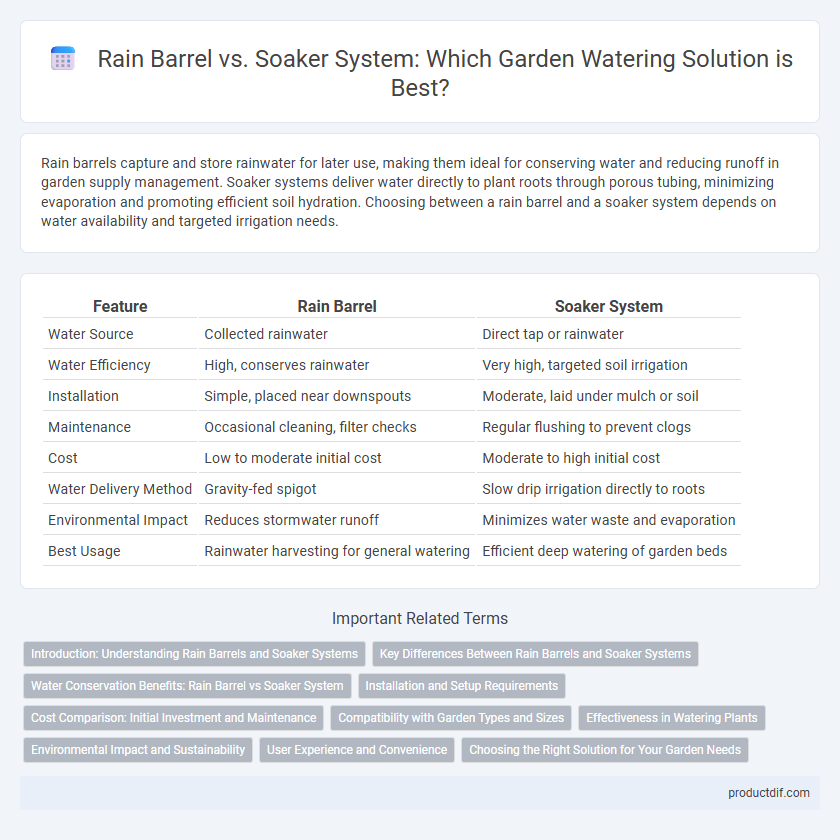Rain barrels capture and store rainwater for later use, making them ideal for conserving water and reducing runoff in garden supply management. Soaker systems deliver water directly to plant roots through porous tubing, minimizing evaporation and promoting efficient soil hydration. Choosing between a rain barrel and a soaker system depends on water availability and targeted irrigation needs.
Table of Comparison
| Feature | Rain Barrel | Soaker System |
|---|---|---|
| Water Source | Collected rainwater | Direct tap or rainwater |
| Water Efficiency | High, conserves rainwater | Very high, targeted soil irrigation |
| Installation | Simple, placed near downspouts | Moderate, laid under mulch or soil |
| Maintenance | Occasional cleaning, filter checks | Regular flushing to prevent clogs |
| Cost | Low to moderate initial cost | Moderate to high initial cost |
| Water Delivery Method | Gravity-fed spigot | Slow drip irrigation directly to roots |
| Environmental Impact | Reduces stormwater runoff | Minimizes water waste and evaporation |
| Best Usage | Rainwater harvesting for general watering | Efficient deep watering of garden beds |
Introduction: Understanding Rain Barrels and Soaker Systems
Rain barrels collect and store rainwater from rooftops, providing an eco-friendly way to water gardens during dry spells. Soaker systems deliver water directly to plant roots through porous tubing, ensuring efficient moisture absorption and reducing water waste. Both methods enhance garden irrigation but serve different purposes based on water conservation and plant needs.
Key Differences Between Rain Barrels and Soaker Systems
Rain barrels collect and store rainwater from rooftops for later garden watering, reducing reliance on municipal water and promoting sustainability. Soaker systems deliver water directly to plant roots through buried or surface-level tubing, ensuring efficient deep soil moisture and minimizing evaporation. Unlike rain barrels that store water, soaker systems automate irrigation, providing consistent and targeted watering ideal for garden beds.
Water Conservation Benefits: Rain Barrel vs Soaker System
Rain barrels capture and store rainwater from rooftops, reducing reliance on municipal water and minimizing runoff that can cause erosion and pollution. Soaker systems deliver water directly to plant roots using slow, efficient drip irrigation, significantly reducing evaporation and water waste compared to traditional overhead watering. Both methods enhance water conservation, with rain barrels providing a sustainable water source and soaker systems optimizing water use efficiency in garden irrigation.
Installation and Setup Requirements
Rain barrels require a simple setup involving placement under a downspout and securing a spigot for water access, typically needing minimal tools and no plumbing alterations. Soaker systems demand a more involved installation process, including laying perforated tubing in garden beds, connecting to a water source, and often integrating timers or pressure regulators for efficient irrigation. The ease of rain barrel installation makes it suitable for beginner gardeners, while soaker systems offer more precise watering control, ideal for established garden landscapes.
Cost Comparison: Initial Investment and Maintenance
Rain barrels typically require a lower initial investment, averaging around $70 to $150, while soaker systems range from $100 to $300 depending on garden size and complexity. Maintenance for rain barrels is minimal, mostly involving occasional cleaning to prevent clogging, whereas soaker systems demand more regular upkeep to check for leaks and ensure even water distribution. Evaluating cost-effectiveness involves balancing the upfront savings of rain barrels against the efficient water delivery and long-term benefits provided by soaker systems.
Compatibility with Garden Types and Sizes
Rain barrels suit small to medium-sized gardens, effectively collecting and storing rooftop runoff for later use, making them ideal for gardens with limited space or non-irrigated areas. Soaker systems are compatible with various garden sizes, especially larger or densely planted beds, delivering water directly to the soil and roots, minimizing evaporation and runoff. Both systems complement diverse garden types, but rain barrels depend on roof runoff availability, while soaker systems require a connected water source for efficient irrigation.
Effectiveness in Watering Plants
Rain barrels collect and store rainwater, providing a sustainable source for watering plants, but their effectiveness depends on manual distribution and may result in uneven soil moisture. Soaker systems deliver water directly to the plant roots through porous tubing, ensuring consistent and efficient moisture levels, reducing water waste and promoting healthier plant growth. For optimal irrigation, soaker systems often outperform rain barrels in maintaining uniform soil hydration and preventing water runoff.
Environmental Impact and Sustainability
Rain barrels capture and store rainwater, reducing reliance on municipal water and minimizing stormwater runoff that can carry pollutants into local waterways. Soaker systems deliver water directly to plant roots through porous tubing, significantly decreasing evaporation and water waste, promoting efficient irrigation. Both methods support sustainability by conserving water resources and reducing environmental strain, but rain barrels emphasize harvesting natural rainfall while soaker systems optimize water usage.
User Experience and Convenience
Rain barrels offer a convenient way to collect and store rainwater for garden use, reducing reliance on municipal water and lowering utility bills. Soaker systems provide precise, low-pressure watering directly to plant roots, minimizing water waste and promoting healthier plant growth. Users find rain barrels ideal for intermittent water collection, while soaker systems excel in delivering consistent moisture with minimal effort, enhancing overall garden maintenance convenience.
Choosing the Right Solution for Your Garden Needs
Rain barrels capture and store rainwater, providing an eco-friendly and cost-effective way to water your garden during dry periods, ideal for small to medium-sized gardens. Soaker systems deliver water directly to plant roots through porous tubing, enhancing water efficiency and reducing evaporation, making them suitable for large or densely planted areas. Evaluating garden size, plant types, and water availability helps determine whether a rain barrel or soaker system best meets your irrigation needs.
Rain barrel vs Soaker system Infographic

 productdif.com
productdif.com